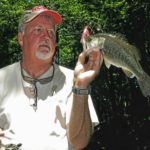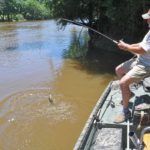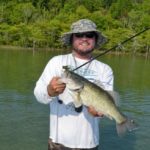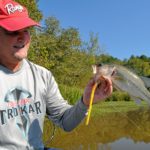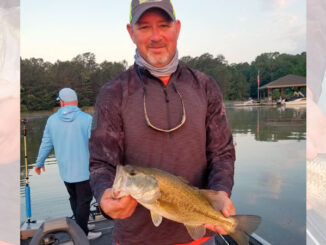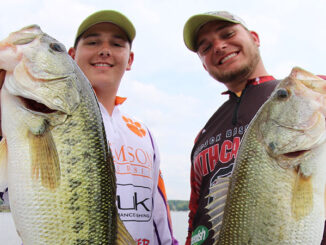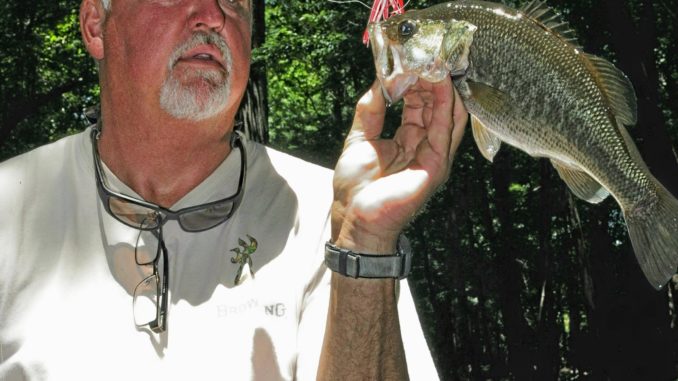
North Carolina’s coastal rivers offer great bass fishing for anglers who learn to fish the quiet, moving waters.
During April, many North Carolina bass anglers’ favorite targets are farm ponds, city reservoirs or flood-control lakes.
But bass bonanzas within a few miles of anglers’ homes may be overlooked. Even better, they’re often unpressured and offer excellent action. Some of North Carolina’s best fishing is in rivers that drain the eastern half of the state, including the Roanoke, Neuse, Tar, Trent, White Oak, New, Cape Fear and Northeast Cape Fear.
Anglers need to key on a few factors to ensure success: water flow, water levels and coloration, plus minimal hurricane effects. As a rule, prespawn river bass head for the mouth of feeder creek in early spring where the water often is warmer than in deep, main channels, and current flow is slower. Creeks and backwaters offer spawning spots with minimal concerns for silt to cover eggs or sweep them downstream.
Here is a look at the bass fishing in some of North Carolina’s coastal rivers.
Cape Fear River
One of the best rivers for bass in the Piedmont, the Cape Fear, begins downstream of Jordan Lake at the confluence of the Haw and Deep rivers in Chatham County. It drains the Piedmont and southeastern North Carolina and runs 210 miles southeast into the Atlantic Ocean.
Anglers can launch boats at a ramp on the northeast side of the river next to the NC 42 bridge that accesses a 460-acre pool created by Buckhorn Dam, about 2½ miles downstream from the bridge.
Decades before Jordan and Shearon Harris lakes were impounded, locals spent pleasant weekends at Buckhorn. Jeff Thomas of Broadway, a guide and former bass pro, said his uncle taught him to fish for bucketmouths at Buckhorn.
“This place was wonderful in the ’70s,” said Thomas (919-770-4654). “People used to come here on Saturday and Sunday afternoons to picnic, ride in small boats or fish.”
The 12-foot-tall Buckhorn Dam, built in 1905, spans 1,150 feet of the river, making it impassable to motorized boats. The US 401 Bridge near Lillington is13.8 miles downstream, a rockier and shallower stretch than the Buckhorn pool.
With little fishing pressure for 60 years, largemouths and other species thrived at Buckhorn.
“I suppose (Buckhorn pool) had baitfish, but when they built Jordan Lake, the river got a lot of threadfin shad and maybe some bass got through,” Thomas said. “Baitfish were the key, because now Buckhorn is full of baitfish. The Deep River also added baitfish.”
Largemouths, stocked striped bass, stocked hybrids and threadfin shad routinely escaped Jordan and into the river after its dam closed in 1982.
Thomas, 51, who competed for 10 years in three major pro bass circuits and won 12 events, often used Buckhorn as a morale booster.
“When I was on the road and had a bad day, I could come out here and have a good day,” he said. “It helped build up my confidence.”
April usually means the river receiving stained, cold water from rains and releases from the bottom of Jordan Lake.
“It’s prespawn time for bass,” Thomas said, “that means I’ll use a spinnerbait and often a 3/8-ounce buzzbait. Back in the day, I threw a dark plastic worm. Now I throw a 3/4-ounce spinnerbait with a big Colorado blade that thumps.”
“If I’m fishing grass or blowdowns at the shoreline, I like a floating worm with 12-pound fluorocarbon line because I don’t want any stretch,” he said. “I’ll use an Eagle Claw Trokar 3/0 hook for the worm. The rest of the setup is the same.”
Thomas said prespawn bass can be found at the mouths of Bush, Lick and Yarborough creeks a mile below the Jordan dam.
“Bush warms up earlier than the others,” he said. “I’ve seen ’em spawning up there behind the rocks. Some of the biggest bass are caught in late March in creeks. My best was an 8-pounder, but typically you catch 4- and 5-pounders.”
Thomas also fishes the Deep River.
“Two things you don’t need in spring are high, fast-moving water or real muddy water,” he said.
Anglers fish other stretches of the Cape Fear although it has old dams. Lanier Falls at Lillington marks the fall line, and only canoe and kayak anglers can get through rocks at Raven Rock State Park. To the east, the river has three locks and dams including No. 3 at Fayetteville, No. 2 at Elizabethtown and No. 1 near Riegelwood.
Neuse/Trent
Upstream from New Bern, where it merges with the Trent River, the Neuse River narrows and has enough freshwater to support largemouths.
“The Trent became a really good bass river last year,” said Ben Ricks, a Commission fisheries biologist. “We’ve shocked up 8-pounders, the biggest coastal bass collected in the last 25 years.”
Angler Lee Lanier of Snow Hill uses a jet-drive, aluminum skiff to go up or downstream from a ramp at the base of the US 70 bridge in Kinston. The river’s normal width varies from 50 to 80 yards, with swamps on both sides and shorelines dotted by bald cypresses and willow trees. Antebellum-era drainage ditches that empty swamp water into the Neuse often are chocked full of bass.
“The bass fishing was about the same — really good — in winter or summer during low-water times,” Lanier said. “Water flows out of the ditches and pulls out minnows, crawfish, insects, earthworms and small snakes for bass.”
Lanier has caught 7- and 8-pounders, although the average is 2 to 4. In the spring, 30-bass days aren’t uncommon.
“If the river’s rising, the bite shuts down,” Lanier said. “The best time is when the river’s at 5 feet and falling or there hasn’t been any big upstream rains or releases.”
With a low flow in the Neuse, Lanier chooses a buzzbait, spinnerbait or a 6-inch pink floating worm. He targets wood along river banks or bag and web worms that fall off cypress trees.
White Oak
The White Oak’s 40-mile journey begins in the swamps of northern Onslow and southern Jones counties, where it forms the southwestern boundary of the Croatan National Forest before flowing past Swansboro and emptying into the Atlantic Ocean at Bogue Inlet.
The lower 10 miles is a tidal estuary.
“I go up the river if the wind’s blowing hard or the redfish aren’t biting in April,” said guide Rick Patterson of Cape Carteret (252-342-1513). “It’s good bass fishing when they’re between the prespawn and spawn. I throw jerkbaits and pitch soft-plastic lures around brush.”
Unlike the Neuse, bass bite more during high-tidal periods.
“If the tide’s dropping, largemouths disappear from the upper reaches of the White Oak,” he said.
Patterson bass fishes when the water temperature rises to 58 degrees.
That’s when “they start staging in the upper river,” he said.
Patterson likes a Bagley Bang-O-Lure, a jerkbait that resembles a wounded bluegill. Some models come with a tail propeller.
“I’ll also throw spinnerbaits and soft-plastics around blowdowns and stumps,” he said.
Good days on the upper White Oak may produce 25 to 30 fish, “if you can catch the right tide,” Patterson said. “The water’s so dark you can’t sight-fish. If I’m using spinnerbaits, I like a 1/4-ounce model with a single willow-leaf or (a) Colorado blade that thumps.”
White Oak bass are typical for the coast — small-to-medium-size fish with an occasional lunker.
“I catch mostly 21/2- to 3-pounders, but guys have caught bigger fish,” he said.
New River
Guide Ricky Kellum of Jacksonville (910-330-2745) normally targets spotted seatrout or red drum during April, but he catches plenty of largemouths.
“But where I catch specks with a Storm Shrimp (north of Jacksonville), I’ll also catch bass,” he said. “The bass guys throw jerkbaits, Rapalas and topwater lures.”
Targeted areas include woody cover over deep water, plus flats with stumps.
“The shoreline in the river above Jacksonville has a lot of oak or pine tree tops hanging over deep water,” he said. “People fish (soft-plastic lures) at the shoreline under tree tops in 10 to 15 feet of water.”
Bass spawn along the shorelines all the way to Richlands.
“That section is 10 miles of crooks and curves, with a lots of shoreline structure,” said Kellum, whose most-productive lure is a Halo Swimming Shad, which mimics small mullet and menhaden.
“You catch bass and specks,” he said. “The best (bite) is on slow-falling or incoming (tide). Bass do nothing on dead water. As long as water’s moving, you’ll have a bite.”
Largemouths spawn during April in the New River.
“There’ll be a topwater bite, too,” he said. “I throw a No. 4 Zara Spook Junior, but I change out hooks to 4X size. One guy last year had 30 bass by 10 a.m. (that) he caught off a 100-yard stretch of stumps up there.”
Roanoke/Pamlico
Guide Richard Andrews of Bath fishes the Pamlico and Roanoke rivers.
“I usually target stripers in the spring on the lower Roanoke near Jamesville, but we catch largemouths at the same spots with the same lures: a 3/8-ounce Z-Man paddletail jig, a Rapala Husky Jerk or an X-Rap suspending jerkbait,” he said.
Andrews (252-945-9715) fishes creeks or “guts.” He casts to dirty water flowing out of swamps where herring spawn. Bass and stripers ambush herring at these plumes.
Roanoke Rapids Dam is the first obstruction for 133.6 miles upstream from the river’s mouth at the Albemarle Sound downstream from Plymouth. The river is navigable until it reaches a series of shoals around Weldon.
Many of the river’s biggest bass live between a mile downstream of the ramp upstream six miles to Roanoke Rapids Dam. Anglers drift flat-bottom skiffs or use jet-drive outboards in this shallow section. They cast topwater lures such as Chug Bugs, Pop-Rs, Zara Spooks and soft-plastic jerk shads across the current at shoreline structure or near rock eddies where bass hide.
On Feb. 12, 2000, an gler Thomas Edenbeck caught a 14-pound, 8-ounce bass on a spinnerbait from the river near the town of Gaston.
Salinity affects Pamlico River bass fishing, which occurs mostly upstream from Little Washington.
“When there’s a wet spring, creeks off the Pamlico, like Blounts, have freshwater upstream and bass,” Andrews said. “They average 2 to 3 pounds, with an occasional 4- or 5-pounder.”

